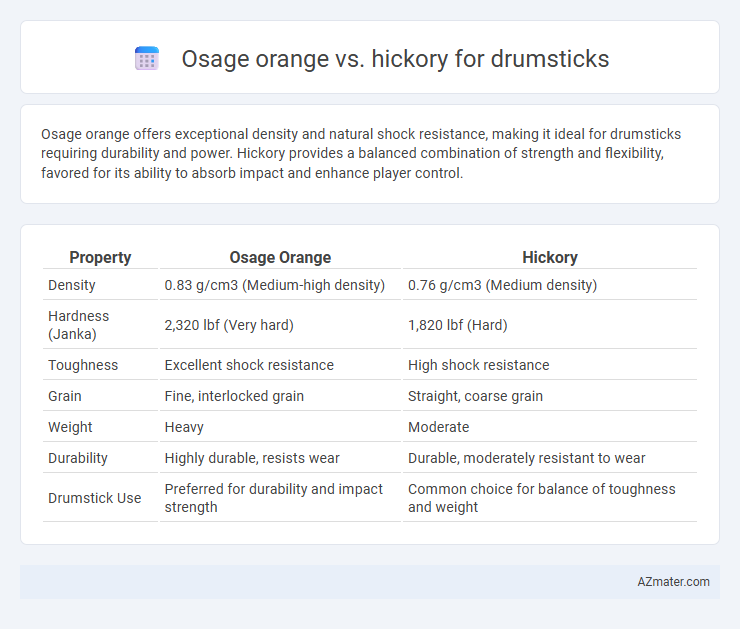Osage orange offers exceptional density and natural shock resistance, making it ideal for drumsticks requiring durability and power. Hickory provides a balanced combination of strength and flexibility, favored for its ability to absorb impact and enhance player control.
Table of Comparison
| Property | Osage Orange | Hickory |
|---|---|---|
| Density | 0.83 g/cm3 (Medium-high density) | 0.76 g/cm3 (Medium density) |
| Hardness (Janka) | 2,320 lbf (Very hard) | 1,820 lbf (Hard) |
| Toughness | Excellent shock resistance | High shock resistance |
| Grain | Fine, interlocked grain | Straight, coarse grain |
| Weight | Heavy | Moderate |
| Durability | Highly durable, resists wear | Durable, moderately resistant to wear |
| Drumstick Use | Preferred for durability and impact strength | Common choice for balance of toughness and weight |
Introduction to Osage Orange and Hickory for Drumsticks
Osage orange wood, known for its dense, elastic properties and striking yellow-orange hue, offers exceptional durability and springiness, making it a popular choice for drumsticks that require both resilience and a bright, articulate sound. Hickory, prized for its balanced combination of strength, flexibility, and shock absorption, provides robust durability and a natural feel, favored in drumsticks designed for heavy-impact playing and versatility across genres. Both woods deliver distinct tonal characteristics--Osage orange producing sharp, crisp accents, while hickory yields warm, rich tones--catering to varied drumming styles and performance needs.
Botanical Overview: Osage Orange vs. Hickory
Osage Orange (Maclura pomifera) is a dense, fine-grained hardwood known for its bright yellow-orange heartwood and resistance to wear, making it ideal for drumsticks that require durability and strength. Hickory (Carya spp.), particularly shagbark and pignut varieties, offers exceptional shock resistance and a balanced weight, favored for its combination of toughness and flexibility in drumstick production. Both species provide unique tactile and acoustic properties, with Osage Orange delivering a harder, more durable feel and Hickory offering resilience and comfort for extended play.
Physical Properties and Hardness Comparison
Osage orange exhibits a dense, fine-grained texture with a Janka hardness of approximately 2,300 lbf, making it exceptionally durable and resistant to wear for drumsticks. Hickory, renowned for its shock resistance and toughness, has a slightly lower Janka hardness around 1,820 lbf, providing a balanced combination of strength and flexibility ideal for percussion use. The higher density and stiffness of Osage orange contribute to a solid, articulate strike, whereas hickory offers resilience that absorbs impact, reducing hand fatigue during extended play.
Weight and Balance: Impact on Drumming Technique
Osage orange drumsticks are known for their lightweight and excellent balance, providing enhanced speed and control for intricate drumming techniques, while Hickory sticks offer a heavier feel with solid durability, promoting powerful strokes and stability. The lighter weight of Osage orange allows for quick rebounds and increased articulation, making them ideal for fast, precise playing. Hickory's denser composition improves endurance and impact resistance, benefiting drummers who require strength and consistent stick response.
Durability and Longevity of Drumsticks
Osage orange drumsticks are renowned for their exceptional durability due to the wood's dense, hard nature, making them highly resistant to wear and chipping during vigorous playing. Hickory drumsticks offer a balance of strength and flexibility, providing good shock absorption while maintaining respectable longevity under regular use. When prioritizing durability and long-term performance, Osage orange often outperforms hickory, especially in heavy hitting or aggressive drumming styles.
Sound Quality: Osage Orange vs. Hickory
Osage Orange offers exceptional tonal qualities with a bright, clear sound and strong projection, making it ideal for drumsticks that emphasize articulation and responsiveness. Hickory provides a warmer, more balanced tone with excellent shock absorption, enhancing comfort during extended play while delivering consistent impact sound. Drummers seeking sharp attack and durability may prefer Osage Orange, whereas those valuing a smooth, controlled sound often choose Hickory for their drumsticks.
Grip Comfort and Ergonomic Differences
Osage orange drumsticks offer a dense, heavy wood that provides excellent shock absorption and a comfortable grip, reducing hand fatigue during extended play. Hickory, known for its balance of strength and flexibility, delivers a lighter feel with natural cushion from the wood grain, enhancing ergonomic comfort and control. Both woods feature distinct textures--Osage orange has a coarse surface that improves grip stability, while hickory's smoother finish supports a more tactile, responsive hold.
Availability and Cost Considerations
Osage orange is moderately available and generally more affordable than hickory, making it a cost-effective choice for drumstick construction. Hickory, known for its superior durability and shock resistance, tends to be pricier and less readily sourced due to slower growth rates and higher demand. Budget-conscious buyers seeking reasonable performance often prefer Osage orange, while those prioritizing premium quality and longevity invest in hickory sticks despite the higher cost.
Player Preferences and Genre Suitability
Osage orange drumsticks are favored by players seeking bright attack and exceptional durability, ideal for genres like rock and funk where powerful, articulate hits are essential. Hickory drumsticks offer a balanced feel with natural shock absorption, preferred in jazz and blues for their warmth and control, enhancing dynamic playing styles. Player preferences often hinge on genre requirements, with Osage orange suited for aggressive, high-impact playing and hickory favored for nuanced, expressive performances.
Final Verdict: Choosing the Right Wood for Drumsticks
Osage orange wood offers exceptional density and hardness, providing drumsticks with superior durability and sharp attack, ideal for powerful playing styles. Hickory, known for its balanced weight and resilience, delivers a comfortable grip and excellent shock absorption, making it suitable for versatile drumming techniques. For drummers prioritizing longevity and a bright, articulate sound, Osage orange is the optimal choice, while those seeking comfort and adaptability should consider hickory.

Infographic: Osage orange vs Hickory for Drumstick
 azmater.com
azmater.com